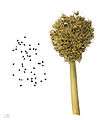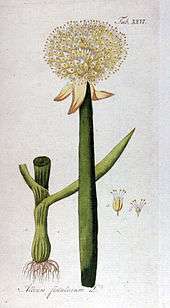Allium fistulosum
Allium fistulosum, commonly called bunching onion, long green onion, Japanese bunching onion, scallion, spring onion, Welsh onion, is a species of perennial plant. The common name "Welsh onion" does not refer to Wales but derives from a near obsolete use of "Welsh" in the sense "foreign, non-native", as the species is native to China, though cultivated in many places and naturalized in scattered locations in Eurasia and North America.[1]
The species is very similar in taste and odor to the related common onion, Allium cepa, and hybrids between the two (tree onions) exist. The Welsh onion, however, does not develop bulbs, and possesses hollow leaves (fistulosum means "hollow") and scapes. Large varieties of the Welsh onion resemble the leek, such as the Japanese negi, whilst smaller varieties resemble chives. Many Welsh onions can multiply by forming perennial evergreen clumps.[2][3] Next to culinary use, it is also grown in a bunch as an ornamental plant.
Historically, the Welsh onion was known as the cibol.[4] In Cornwall, they are known as chibbles.
A. fistulosum is not indigenous to Wales or particularly common in Welsh cuisine (the green Allium common to Wales is the leek, A. ampeloprasum, the national vegetable of Wales).
Ambiguous names
Other names that may be applied to this plant include green onion, salad onion, and spring onion. These names are ambiguous, as they may also be used to refer to any young green onion stalk, whether grown from Welsh onions, common onions, or other similar members of the genus Allium (also see scallion).
Culinary use
The Welsh onion is an ingredient in Asian cuisine, especially in East and Southeast Asia. It is particularly important in China, Japan, and Korea, hence the other English name for this plant, Japanese bunching onion.
In the West, the Welsh onion is primarily used as a scallion or salad onion, but is widely used in other parts of the world, particularly East Asia.[5]
Jamaica
Known as escallion,[6] the Welsh onion is an ingredient in Jamaican cuisine, in combination with thyme, scotch bonnet pepper, garlic, and allspice (called pimenta). Recipes with escallion sometimes suggest leek as a substitute in salads. Jamaican dried spice mixtures using escallion are available commercially.
The Jamaican name is probably a variant of scallion, the term used loosely for the spring onion and various other plants in the genus Allium.
Japan
The Japanese name is negi (ネギ). Common onions were introduced to East Asia in the 19th century, but A. fistulosum remains more popular and widespread.[5] It is used in miso soup, negimaki (beef and scallion rolls),[7] among others, and it is widely sliced up and used as a garnish, such as on teriyaki or takoyaki.
Korea
In Korea, Allium fistulosum along with Allium × wakegi is called pa(파, "scallion"), while common onions are called yangpa(양파, "Western scallion"). Larger Allium fistulosum, looking similar to leek, is called daepa(대파, "big scallion"), while thinner early variety is called silpa(실파, "thread scallion"). A similar scallion plant, Allium × wakegi is called jjokpa(쪽파). Both daepa and silpa are usually used as a spice, herb, or garnish in Korean cuisine. The white part of daepa is often used as the flavour base for various broths and infused oil, while the green part of silpa is preferred as garnish.
Dishes
- paganghoe – a type of ganghoe (parboiled bundled dish), made by parboilling silpa, and tying ojingeo sukhoe (parboiled squid) with it.
- pajangajji – a type of jangajji (pickle), made by pickling chunked daepa with soy sauce-based pickling liquid. The pickling liquid can be made by boiling the mixture of soy sauce, water, kelp, dried red chilli, vinegar, and sugar.
- pamandu – a type of mandu (dumpling), made by slicing the white part of daepa, cutting open the end of it and sticking the stuffing to it to make the hosta-shaped mandu. The stuffing can be made by mixing seasoned ground beef, minced clam meat, minced whitefish flesh, and julienned radish that is salted and squizeed. The mandu is then coated with flour and eggwash, pan-fried, and boiled in salt water. It is served with dipping sauce made of soy sauce, vinegar, minced garlic, chopped scallions, sesame oil, black pepper, and toasted sesame seeds.
- panamul – a type of namul, made by seasoning blanched silpa and boiled mung bean sprout, and parboiled or stir-fried shredded beef brisket, with soy sauce, vinegar, sesame oil, chilli powder, and ground toasted sesame seeds.
- pasanjeok – a type of sanjeok, made by grilling daepa skewered together with seasoned sliced beef. Before being grilled, the daepa and beef skewers are coated first with wheat flour and then with the sauce made of soy sauce, minced garlic, and sugar.
- silpajangguk – a type of jangguk, made by boilling silpa in beef broth seasoned with soup soy sauce, then pouring bitten egg. Ground black pepper can be sprinkled over the soup when served.
Russia
Welsh onions are used in Russia in the spring for adding green leaves to salads.
Image gallery
 Grown in Guizhou, China
Grown in Guizhou, China.jpg) thick daepa type
thick daepa type
(also "Asian leek").jpg) thin silpa type
thin silpa type
(regular scallion) A. fistulosum – MHNT
A. fistulosum – MHNT
See also
References
- 1 2 "World Checklist of Selected Plant Families: Royal Botanic Gardens, Kew". kew.org.
- ↑ "Floridata Profile". floridata.com.
- ↑ Thompson, Sylvia (1995). The Kitchen Garden. Bantam Books.
- ↑ Ward, A: The Encyclopedia of Food and Beverage, New York, 1911. Retrieved January 5, 2007.
- 1 2 Fritsch, R.M.; N. Friesen (2002). "Chapter 1: Evolution, Domestication, and Taxonomy". In H.D. Rabinowitch and L. Currah. Allium Crop Science: Recent Advances. Wallingford, UK: CABI Publishing. p. 18. ISBN 0-85199-510-1.
- ↑ "MAJOR PESTS OF ESCALLION (ALLIUM FISTULOSUM) IN JAMAICA" (PDF). Ministry of Agriculture and Lands, Jamaica. November 2006.
- ↑ "Recipe – Chicken Negimaki – NYTimes.com". The New York Times. August 13, 2010. Retrieved September 15, 2012.
External links
 Media related to Welsh onion at Wikimedia Commons
Media related to Welsh onion at Wikimedia Commons Data related to Allium fistulosum at Wikispecies
Data related to Allium fistulosum at Wikispecies- PROTAbase on Allium fistulosum
- WORLD'S LARGEST Welsh onion





.jpg)